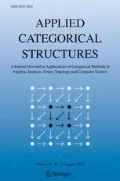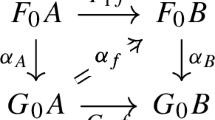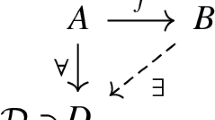Abstract
We introduce, comment and develop the Scott adjunction, mostly from the point of view of a category theorist. Besides its technical and conceptual aspects, in a nutshell we provide a categorification of the Scott topology over a posets with directed suprema. From a technical point of view we establish an adjunction between accessible categories with directed colimits and Grothendieck topoi. We show that the bicategory of topoi is enriched over the 2-category of accessible categories with directed colimits and it has tensors with respect to this enrichment. The Scott adjunction (re-)emerges naturally from this observation.
Similar content being viewed by others
Data availibility
Data sharing not applicable to this article as no datasets were generated or analysed during the current study.
Notes
This is shown in Remark 2.7.
This will be shown in the remark below.
The free completions that adds splittings of pseudo-idempotents.
These are those limits can be reduced to products, inserters and equifiers.
i.e., send filtered colimits in \(\mathscr {A}\) or \(\mathscr {B}\) to limits in \(\mathbf{Set}\).
Here we are using that \(\mathscr {A}\) and \(\mathscr {B}\) are accessible in order to cut down the size of the orthogonality.
This is not strictly true, because the definition of monoidal closed category does not allow for equivalence of categories. We did not find a precise terminology in the literature and we felt non-useful to introduce a new concept for such a small discrepancy.
This is not quite true, we know that e is a subquotient of \(f^*(g)\), in the general case the proof gets a bit messier to follow, for this reason we will cover in detail just this case.
References
Abramsky, S., Jung, A.: Domain Theory. Claendon Press, Oxford (1994)
Vickers, S.: Locales and Toposes as Spaces, pp. 429–496. Springer, Dordrecht (2007)
Di Liberti, I.: Towards higher topology. J. Pure Appl. Algebra 226(3), 106838 (2022)
Di Liberti, I.: Formal Model Theory and Higher Topology. arXiv:2010.00319 (2020)
Henry, S.: An abstract elementary class non axiomatizable in \({L_{\infty ,\kappa }}\). J. Symb. Log. 84(3), 1240–1251 (2019)
Borceux, F.: Handbook of Categorical Algebra. Encyclopedia of Mathematics and its Applications, vol. 3. Cambridge University Press, Cambridge (1994)
Borceux, F.: Handbook of Categorical Algebra. Encyclopedia of Mathematics and its Applications, vol. 1. Cambridge University Press, Cambridge (1994)
Adámek, J., Rosický, J.: Locally Presentable and Accessible Categories. London Mathematical Society Lecture Note Series, vol. 189. Cambridge University Press, Cambridge (1994)
MacLane, S., Moerdijk, I.: Sheaves in Geometry and Logic. Springer, New York (1994)
Johnstone, P.T.: Sketches of an Elephant: A Topos Theory Compendium: 2 Volume Set. Oxford University Press, Oxford (2002)
Anel, M., Lejay, D.: Exponentiable higher toposes (2018)
Karazeris, P.: Categorical domain theory: Scott topology, powercategories, coherent categories. Theory Appl. Categ. 9, 106–120 (2001). (electronic only)
Porst, H.E., Tholen, W.: Concrete dualities. Category theory at work, Herrlich and Porst eds, pp. 11–136. Heldermann-Verlag (1991)
Makkai, M., Pitts, A.M.: Some results on locally finitely presentable categories. Trans. Am. Math. Soc. 299(2), 473–496 (1987)
Makkai, M.: Strong conceptual completeness for first-order logic. Ann. Pure Appl. Log. 40(2), 167–215 (1988)
Caramello, O.: The unification of mathematics via topos theory. arXiv preprint arXiv:1006.3930 (2010)
Johnstone, P.T.: Sketches of an Elephant: A Topos Theory Compendium 1: Volume Set. Oxford University Press, Oxford (2002)
Johnstone, P., Joyal, A.: Continuous categories and exponentiable toposes. J. Pure Appl. Algebra 25(3), 255–296 (1982)
Beke, T.: Theories of presheaf type. J. Symb. Log. 69(3), 923–934 (2004)
Espíndola, C.: Infinitary first-order categorical logic. Ann. Pure Appl. Log. 170(2), 137–162 (2019)
Kelly, G.M., Lawvere, F.W.: On the Complete Lattice of Essential Localizations. Department of Pure Mathematics, University of Sydney, Sydney (1989)
Makkai, M., Paré, R.: Accessible Categories: The Foundations of Categorical Model Theory. American Mathematical Society, Providence (1989)
Paré, R., Rosický, J.: Colimits of accessible categories. Math. Proc. Camb. Philos. Soc. 155(1), 47–50 (2013)
Lieberman, M., Rosický, J.: Limits of abstract elementary classes. Theory Appl. Categ. 30(48), 1647–1658 (2015)
Kelly, G.M.: Basic Concepts of Enriched Category Theory, vol. 64. Cambridge University Press, Cambridge (1982)
Di Liberti, I.: The symmetric monoidal closed structure on the category of \(\cal{F}\)-cocomplete categories and \(\cal{F}\)-cocontinuous functors. MathOverflow. https://mathoverflow.net/users/104432/ivan-di liberti. https://mathoverflow.net/q/350869 (version: 2020-01-21)
Bourke, J.: Skew structures in 2-category theory and homotopy theory. J. Homotopy Relat. Struct. 12(1), 31–81 (2017)
Hyland, M., Power, J.: Pseudo-commutative monads and pseudo-closed 2-categories. J. Pure Appl. Algebra 175(1), 141–185 (2002). Special Volume celebrating the 70th birthday of Professor Max Kelly
Franco, I.L.: Pseudo-commutativity of KZ 2-monads. Adv. Math. 228(5), 2557–2605 (2011)
Adámek, J., Rosický, J.: How nice are free completions of categories? Top. Appl. 273, 106972 (2020)
Brandenburg, M.: Tensor categorical foundations of algebraic geometry. arXiv preprint arXiv:1410.1716 (2014)
Lurie, J.: Higher Topos Theory (AM-170). Princeton University Press, Princeton (2009)
Garner, R., Shulman, M.: Enriched categories as a free cocompletion. Adv. Math. 289, 1–94 (2016)
Pitts, A.: On product and change of base for toposes. Cahiers de topologie et géométrie différentielle catégoriques 26(1), 43–61 (1985)
Adámek, J., El Bashir, R., Sobral, M., Velebil, J.: On functors which are lax epimorphisms. Theory Appl. Categ. 8, 509–521 (2001)
Lieberman, M., Rosickỳ, J., Vasey, S.: Hilbert spaces and C-algebras are not finitely concrete. arXiv preprint arXiv:1908.10200 (2019)
Acknowledgements
I am indebted to my advisor, Jiří Rosický, for the freedom and the trust he blessed me with during these years, not to mention his sharp and remarkably blunt wisdom. I would like to thank Simon Henry, for his collaboration in those days in which this project was nothing but an informal conversation at the whiteboard. I am grateful to Peter Arndt, for his sincere interest in my research, and the hint of looking at the example of the geometric theory of fields. Finally, I am grateful to the anonymous referee for their suggestions and comments.
Author information
Authors and Affiliations
Additional information
Publisher's Note
Springer Nature remains neutral with regard to jurisdictional claims in published maps and institutional affiliations.
This research was mostly developed during the Ph.D. studies of the author and has been supported through the Grant 19-00902S from the Grant Agency of the Czech Republic. The finalization of this research has been supported by the GACR Project EXPRO 20-31529X and RVO: 67985840.
Communicated by Thomas Streicher.
Rights and permissions
About this article
Cite this article
Di Liberti, I. General Facts on the Scott Adjunction. Appl Categor Struct 30, 569–591 (2022). https://doi.org/10.1007/s10485-021-09666-6
Received:
Accepted:
Published:
Issue Date:
DOI: https://doi.org/10.1007/s10485-021-09666-6




